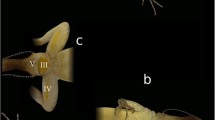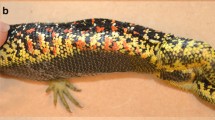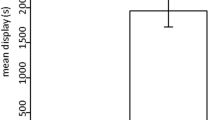Abstract
Sexual selection pressures play a significant role in driving the evolution of color, morphological, and behavioral traits that serve as signals to communicate fighting ability between opponents. In lizards, body and head size often predict the outcome of male-male contests, but these morphological signals are static during and after the contest. However, coloration and behaviors may be dynamic traits that change during interactions being a potential mechanism of continuous evaluation of current or future opponents. In this study, we examine the function of color change as a signal in agonistic interactions between males of the Achala copper lizard. Also, we examine the relationship between fighting ability and multiple traits, including body size, head size, behaviors, and coloration. Furthermore, we explore the variability of agonistic encounters between reproductive and non-reproductive periods. We performed dyadic trials between males to evaluate behavior and measure dorsal color before and after the trials. Results show that Pristidactylus achalensis can modify the lightness of their skin during intrasexual interaction, with winners displaying lighter colors than losers. We observed dramatic changes from very light green to totally dark coloration. Notably, color difference between competitors was distinguishable only after the trial, not before. Winners also displayed more push-up behaviors, predicting the outcome of the agonistic interactions. Additionally, we did not find differences in the behavioral repertoire between periods (reproductive vs non-reproductive). We suggest that push-up behavior and color change are essential signals that allow contenders to assess their opponent’s fighting ability from a distance without physical interaction and settle conflicts without escalating aggression.
Significance statement
Animals may use multiple signals in agonistic interactions to facilite opponent assessment. Although body size and morphological sexual traits usually predict outcome, these traits are static but the dynamic of the coloration through fast color change add an extra factor to interpret the communication. We examine the function of color change as a signal and the relation between fighting ability of an endemic lizard from highlands of central Argentina. We demonstrated that males possess the ability to change their color, and winners show lighter colors than the losers. We suggest color changes together with push-up behavior are essential signals for the resolution of the conflict allowing the contenders to assess the opponent from a distance without physical interaction.




Similar content being viewed by others
Data availability
The data can be found at https://osf.io/2pgju/?view_only=c364a3842dda48019a60d991c00240ec.
References
Ábalos J, Pérez I de Lanuza G, Carazo P, Font E (2016) The role of male coloration in the outcome of staged contests in the European common wall lizard (Podarcis muralis). Behaviour 153:607–631. https://doi.org/10.1163/1568539X-00003366
Alho JS, Herczeg G, Söderman F, Laurila A, Jönsson KI, Merilä J (2010) Increasing melanism along a latitudinal gradient in a widespread amphibian: local adaptation, ontogenic or environmental plasticity? BMC Evol Biol 10:317. https://doi.org/10.1186/1471-2148-10-317
Andersson M (1994) Sexual selection. Princeton University Press, Princeton, NJ
Assis BA, Avery JD, Tylan C, Engler HI, Earley RL, Langkilde T (2021) Honest signals and sexual conflict: female lizards carry undesirable indicators of quality. Ecol Evol 11:7647–7659. https://doi.org/10.1002/ece3.7598
Badiane A, Martin M, Meylan S, Richard M, Decencière Ferrandière B, Le Galliard JF (2020) Male ultraviolet reflectance and female mating history influence female mate choice and male mating success in a polyandrous lizard. Biol J Linn Soc 130:586–598. https://doi.org/10.1093/biolinnean/blaa061
Badyaev AV, Hill GE (2000) Evolution of sexual dichromatism: contribution of carotenoid- versus melanin-based coloration. Biol J Linn Soc 69:153–172. https://doi.org/10.1111/j.1095-8312.2000.tb01196.x
Bajer K, Molnar O, Török J, Herczeg G (2012) Temperature, but not available energy, affects the expression of a sexually selected ultraviolet (UV) colour trait in male European Green Lizards. Plos One 7:e34359. https://doi.org/10.1371/journal.pone.0034359
Bartoń K (2018) MuMIn: multi-model inference. R package, version 0.40.4, http://r-forge.r-project.org/projects/mumin/
Björklund M (1990) A phylogenetic interpretation of sexual dimorphism in body size and ornament in relation to mating system in birds. J Evol Biol 3:171–183. https://doi.org/10.1046/j.1420-9101.1990.3030171.x
Blengini C, López Juri G, Chiaraviglio M, Uñates DR, Naretto S (2020) Sperm parameter in Pristidactylus achalensis (Squamata: Leiosauridae), an endemic lizard to the highest mountain areas in central Argentina. Copeia 108:538–544. https://doi.org/10.1643/CH-19-310
Bohórquez-Alonso ML, Mesa-Avila G, Suárez-Rancel M, Font E, Molina-Borja M (2018) Predictors of contest outcome in males of two subspecies of Gallotia galloti (Squamata: Lacertidae). Behav Ecol Sociobiol 72:63. https://doi.org/10.1007/s00265-018-2480-z
Bradbury JW, Vehrencamp SL (1998) Principles of animal communication, 2nd edn. Sinauer Associates, Sunderland, MA
Bruinjé AC, Coelho FEA, Paiva TMA, Costa GC (2019) Aggression, color signaling, and performance of the male color morphs of a Brazilian lizard (Tropidurus semitaeniatus). Behav Ecol Sociobiol 73:72. https://doi.org/10.1007/s00265-019-2673-0
Carpenter CC, Ferguson GW (1977) Variation and evolution of stereotyped behavior in reptiles. In: Gans C, Bellairs ADA, Parsons TS (eds) Biology of the reptilian, vol 7. Academic Press, London, pp 335–554
Clusella-Trullas S, van Wyk J, Spotila J (2007) Thermal melanism in ectotherms. J Therm Biol 32:235–245. https://doi.org/10.1016/2Fj.jtherbio.2007.01.013
Cooper WE Jr, Greenberg N (1992) Reptilian coloration and behavior. In: Crews D, Gans C (eds) Biology of the Reptilia: physiology and behavior. E: hormones, brain and behavior. University of Chicago Press, Chicago, pp 298–422
Cox RM, Skelly SL, John-Alder HB (2003) A comparative test of adaptive hypotheses for sexual size dimorphism in lizards. Evolution 57:1653–1669. https://doi.org/10.1111/j.0014-3820.2003.tb00371.x
Cuthill IC, Allen WL, Arbuckle K et al (2017) The biology of color. Science 357:eaan0221. https://orcid.org/0000-0002-9171-5874
Dickerson AL, Rankin KJ, Cadena V, Endler JA (2020) Rapid beard darkening predicts contest outcome, not copulation success, in bearded dragon lizards. Anim Behav 170:167–176. https://doi.org/10.1016/j.anbehav.2020.10.014
Dollion AY, Herrel A, Marquis O, Leroux-COyau M, Meylan S (2020) The colour of success: does female mate choice rely on male colour change in the chameleon Furcifer pardalis? J Exp Biol 223:jeb224550. https://doi.org/10.1242/jeb.224550
Dollion AY, Meylan S, Marquis O, Leroux-Coyau M, Herrel A (2022) Do male panther chameleons use different aspects of color change to settle disputes? Sci Nat 109:13. https://doi.org/10.1007/s00114-022-01784-y
Duarte RC, Stevens M, Flores AAV (2016) Shape, colour plasticity, and habitat use indicate morph-specific camouflage strategies in a marine shrimp. BMC Evol Biol 16:218. https://doi.org/10.1186/s12862-016-0796-8
Elias DO, Kasumovic MM, Punzalan D, Andrade MCB, Mason AC (2008) Assessment during aggressive contests between male jumping spiders. Anim Behav 76:901–910. https://doi.org/10.1016/2Fj.anbehav.2008.01.032
Endler JA, Thery M (1996) Interacting effects of lek placement, display behavior, ambient light, and color patterns in three neotropical forest-dwelling birds. Am Nat 148:421–452. http://www.jstor.org/stable/2463298
Endler JA, Basolo AL (1998) Sensory ecology, receiver biases and sexual selection. Trends Ecol Evol 13:415–420. https://doi.org/10.1016/S0169-5347(98)01471-2
Endler JA, Day LB (2006) Ornament colour selection, visual contrast and the shape of colour preference functions in great bowerbirds, Chlamydera nuchalis. Anim Behav 72:1405–1416. https://doi.org/10.1016/j.anbehav.2006.05.005
Endler JA (1992) Signals, signal conditions, and the direction of evolution. Am Nat 139:125–153. http://www.jstor.org/stable/2462431
Fernández JB, Bastiaans E, Medina M, Mendez de la Cruz FR, Sinervo B, Ibargüengoytía NR (2018) Behavioral and physiological polymorphism in males of the austral lizard Liolaemus sarmientoi. J Comp Physiol A 204:219–230. https://doi.org/10.1007/s00359-017-1233-1
Fleishman LJ, Bowman M, Saunders D, Miller WE, Rury MJ, Loew ER (1997) The visual ecology of Puerto Rican anoline lizards: habitat light and spectral sensitivity. J Comp Physiol A 181:446–460. https://doi.org/10.1007/s003590050128
Fleishman LJ, Loew ER, Whiting MJ (2011) High sensitivity to short wavelengths in a lizard and implications for understanding the evolution of visual systems in lizards. Proc R Soc Lond B 278:2891–2899. https://doi.org/10.1098/rspb.2011.0118
Gammell MP, Hardy ICW (2003) Contest duration: sizing up the opposition? Trends Ecol Evol 18:491–493. https://doi.org/10.1016/S0169-5347(03)00222-2
González-Morales JC, Rivera-Rea J, Moreno-Rueda G, Bastiaans E, Díaz-Albiter H, Díaz de la Vega-Pérez AH, Bautista A, Fajardo V (2021) To be small and dark is advantageous for gaining heat in mezquite lizards, Sceloporus grammicus (Squamata: Phrynosomatidae). Biol J Linn Soc 132:93–103. https://doi.org/10.1093/biolinnean/blaa176
Greenberg N, Crews D (1990) Endocrine and behavioral responses to aggression and social dominance in the green anole lizard, Anolis carolinensis. Gen Comp Endocrinol 77:1–10. https://doi.org/10.1016/0016-6480(90)90309-a
Haeghen YV (2009) https://imagejdocu.list.lu/plugin/color/chart_white_balance/start
Herrel A, De Grauw E, Lemos-Espinal JA (2001) Head shape and bite performance in Xenosaurid lizards. J Exp Zool 290:101–107. https://doi.org/10.1002/jez.1039
Hsu Y, Earley RL, Wolf LL (2006) Modulation of aggressive behaviour by fighting experience: mechanisms and contest outcomes. Biol Rev 81:33–74. https://doi.org/10.1017/s146479310500686x
Husak JF, Lappin AK, Fox SF, Lemos-Espinal JA (2006) Bite-force performance predicts dominance in male venerable collared lizards (Crotaphytus antiquus). Copeia 2006:301–306. http://www.jstor.org/stable/4098606
Irschick DJ, Ramos M, Buckley C, Elstrott J, Carlisle E, Lailvaux SP, Bloch N, Herrel A, Vanhooydonck B (2006) Are morphology performance relationships invariant across different seasons? A test with the green anole lizard (Anolis carolinensis). Oikos 114:49–59. https://doi.org/10.1111/j.2006.0030-1299.14698.x
Johnstone RA (1996) Multiple displays in animal communication: “backup signals” and “multiple messages.” Phil Trans R Soc B 351:329–338. https://doi.org/10.1098/rstb.1996.0026
Kar F, Whiting MJ, Noble DWA (2016) Influence of prior contest experience and level of escalation on contest outcome. Behav Ecol Sociobiol 70:1679–1687. https://doi.org/10.1007/s00265-016-2173-4
Kemp DJ, Herberstein ME, Fleishman LJ, Endler JA, Bennett AT, Dyer AG, Hart NS, Marshall J, Whiting MJ (2015) An integrative framework for the appraisal of coloration in nature. Am Nat 185:705–724. https://doi.org/10.1086/681021
Kopena R, Lopez P, Majlathova V, Martin J (2020) Sexually dichromatic coloration of female Iberian green lizards correlates with health state and reproductive investment. Behav Ecol Sociobiol 74:131. https://doi.org/10.1007/s00265-020-02915-z
Lailvaux SP, Herrel A, VanHooydonck B, Meyers JJ, Duncan I (2004) Performance capacity, fighting tactics and the evolution of life–stage male morphs in the green anole lizard (Anolis carolinensis). Proc R Soc Lond B 271:2501–2508. https://doi.org/10.1098/rspb.2004.2891
Ligon RA, McGraw KJ (2013) Chameleons communicate with complex colour changes during contests: different body regions convey different information. Biol Lett 9:20130892. https://doi.org/10.1098/rsbl.2013.0892
Loew ER, Fleishman LJ, Foster RG, Provencio I (2002) Visual pigments and oil droplets in diurnal lizards: a comparative study of Caribbean anoles. J Exp Biol 205:927–938. https://doi.org/10.1242/jeb.205.7.927
López Juri G, Chiaraviglio M, Cardozo G (2018) Macroevolution of sexual size dimorphism and reproduction-related phenotypic traits in lizards of the Chaco Domain. BMC Evol Biol 18:186. https://doi.org/10.1186/s12862-018-1299-6
Merilaita S, Stevens M (2011) Crypsis through background matching. In: Stevens M, Merilaita S (eds) Animal camouflage: mechanisms and function. Cambridge University Press, Cambridge, UK, pp 17–33
Mesterton-Gibbons M, Heap SM (2014) Variation between self- and mutual assessment in animal contests. Am Nat 183:199–213. https://doi.org/10.1086/674443
Molina-Borja M, Padron-Fumero M, Alfonso-Martin T (1998) Morphological and behavioural traits affecting the intensity and outcome of male contests in Gallotia galloti galloti (Family Lacertidae). Ethology 104:314–322. https://doi.org/10.1111/j.1439-0310.1998.tb00071.x
Møller AP, Pomiankowski A (1993) Why have birds got multiple sexual ornaments? Behav Ecol Sociobiol 32:167–176. https://doi.org/10.1007/BF00173774
Morrel LJ, Backwell PRY, Metcalfe NB (2005) Fighting in fiddler crabs Uca mjoebergi: what determines duration? Anim Behav 70:653–662. https://doi.org/10.1016/j.anbehav.2004.11.014
Morrow EH, Pitcher TE (2003) Sexual selection and the risk of extinction in birds. Proc R Soc Lond B 270:1793–1799. https://doi.org/10.1098/rspb.2003.2441
Naretto S, Chiaraviglio M (2020) Factors driving sexual dimorphism and colour variability in Achala copper Lizard (Pristidactylus achalensis), an endemic species to the highland mountains in Central Argentina. Can J Zool 98:377–389. https://doi.org/10.1139/cjz-2019-0293
Naretto S, Cardozo G, Blengini C, Chiaraviglio M (2014) Sexual selection and dynamics of jaw muscle in Tupinambis lizards. Evol Biol 41:192–200. https://doi.org/10.1007/s11692-013-9257-0
Naretto S, Cabezas-Cartes F, López Juri G, Chiaraviglio M (2022) Intraspecific variability of bite force in Achala copper lizards in a sexual selection context: who bites harder and when and why? Biol J Linn Soc 136:282–292. https://doi.org/10.1093/biolinnean/blac034
Olsson M (1992) Contest success in relation to size and residency in male sand lizards, Lacerta agilis. Anim Behav 44:386–388. https://doi.org/10.1016/0003-3472(92)90046-C
Ord TJ, Blumstein DT, Evans CS (2001) Intrasexual selection predicts the evolution of signal complexity in lizards. Proc R Soc Lond B 268:737–744. https://doi.org/10.1098/rspb.2000.1417
Parker GA (1974) Assessment strategy and the evolution of fighting behaviour. J Theor Biol 47:223–243. https://doi.org/10.1016/0022-5193(74)90111-8
R Development Core Team (2017) R: a language and environment for statistical computing. R Foundation for Statistical Computing, Vienna, Austria, http://www.R-project.org
Reguera S, Zamora-Camacho FJ, Moreno-Rueda G (2014) The lizard Psammodromus algirus (Squamata: Lacertidae) is darker at high altitudes. Biol J Linn Soc 112:132–141. https://doi.org/10.1111/bij.12250
Rossi N, Chiaraviglio M, Cardozo G (2022) Relationships among behavior, chromatism, and morphology in male aggressive encounters in Tropidurus spinulosus. Ichthyol Herpetol 110:340–349. https://doi.org/10.1643/h2021025
Sánchez-Hernández P, Molina Borja M (2019) Development and outcome of intrasexual contests in males and females of Chalcides viridanus (Fam. Scincidae) along breeding period. Behaviour 156:1349–1369. https://doi.org/10.1163/1568539X-00003569
Siddiqi A, Cronin TW, Loew ER, Vorobyev M, Summers K (2004) Interspecific and intraspecific views of color signals in the strawberry poison frog Dendrobates pumilio. J Exp Biol 207:2471–2485
Smith KR, Cadena V, Endler JA, Porter WP, Kearney MR, Stuart-Fox D (2016) Colour change on different body regions provides thermal and signalling advantages in bearded dragon lizards. Proc R Soc B 283:20160626. https://doi.org/10.1098/rspb.2016.0626
Stuart-Fox D, Moussalli A (2008) Selection for social signalling drives the evolution of chameleon colour change. Plos Biol 6:e25. https://doi.org/10.1371/journal.pbio.0060025
Stuart-Fox D, Moussalli A (2009) Camouflage, communication and thermoregulation: lessons from colour changing organisms. Phil Trans R Soc B 364:463–470. https://doi.org/10.1098/rstb.2008.0254
Stuart-Fox DM, Firth D, Mousalli A, Whiting MJ (2006) Multiple signals in chameleon contests: designing and analysing animal contests as a tournament. Anim Behav 71:1263–1271. https://doi.org/10.1016/j.anbehav.2005.07.028
Stuart-Fox D, Moussalli A, Whiting MJ (2008) Predator-specific camouflage in chameleons. Biol Lett 4:326–329. https://doi.org/10.1098/2Frsbl.2008.0173
Summers CH, Greenberg N (1994) Somatic correlates of adrenergic activity during aggression in the lizard, Anolis carolinensis. Horm Behav 28:29e40. https://doi.org/10.1006/hbeh.1994.1003
Torres MM, Viladrich LJ, Naretto S (2019) A case of cannibalism in Achala copper lizard Pristidactylus achalensis, an endemic lizard to the highest mountain areas in Central Argentina (Squamata: Leiosauridae). Herpetol Notes 12:827–828
Torres MM, Viladrich LJ, Naretto S (2021) Role of coloration in antipredator strategies in Pristidactylus achalensis (Squamata: Leiosauridae) related to sex and stages of predation. Biol J Linn Soc 133:896–909. https://doi.org/10.1093/biolinnean/blab012
Troscianko J, Stevens M (2015) Image calibration and analysis toolbox – a free software suite for objectively measuring reflectance, colour and pattern. Methods Ecol Evol 6:1320–1331
Umbers K, Fabricant S, Gawryszewski F, Seago A, Herberstein M (2014) Reversible colour change in Arthropoda. Biol Rev 89:820–848. https://doi.org/10.1111/brv.12079
Vidal MA, Ortiz JC, Labra A (2007) Sexual and geographic variation of color patterns in Liolaemus tenuis (Squamata, Liolaeminae). Gayana 71:27–33
Vorobyev M, Osorio D (1998) Receptor noise as a determinant of colour thresholds. Proc R Soc Lond B 265:351–358
Whiting MJ (1999) When to be neighbourly: differential agonistic responses in the lizard Platysaurus broadleyi. Behav Ecol Sociobiol 46:210–214. https://doi.org/10.1007/s002650050611
Whiting MJ, Stuart-Fox DM, O’Connor D, Firth D, Bennett NC, Blomberg SP (2006) Ultraviolet signals ultra aggression in a lizard. Anim Behav 72:353–363. https://doi.org/10.1016/j.anbehav.2005.10.018
Whiting MJ, Branch WR, Pepper M, Keogh JS (2015) A new species of spectacularly coloured flat lizard Platysaurus (Squamata: Cordylidae: Platysaurinae) from southern Africa. Zootaxa 3986:173–192. https://doi.org/10.11646/zootaxa.3986.2.2
Wu Y, Whiting MJ, Fu J, Qi F (2019) The driving forces behind female-female aggression and its fitness consequence in an Asian agamid lizard. Behav Ecol Sociobiol 73:73. https://doi.org/10.1007/s00265-019-2686-8
Zucker N (1989) Dorsal darkening and territoriality in a wild population of the tree lizard, Urosaurus ornatus. J Herpetol 23:389e398. https://doi.org/10.2307/1564050
Acknowledgements
Special thanks go to Guadalupe López Juri for providing assistance with field data collection and to Diego Uñates for helping with color analyzes. German Gonzalez provided helpful advice regarding statistical analyzes. Hotel La Posta (Cordoba) offers valuable logistical support in the fieldwork area, mountain guide Hernan Casasnovas provided value field observations and Martyna Kotowska offers advice regarding English corrections.
Funding
Funding was provided by Consejo Nacional de Investigaciones Científicas y Técnicas (CONICET), Fondo para la Investigación Científica y Tecnológica (FONCyT), MinCyT-Préstamo BID-PICT. 2015 No. 497, Consejo Nacional de Investigaciones Científicas y Técnicas (CONICET) PUE-2016 D2555/16 and PIP-2021 Number 67908, CO 112202000100028. Facultad de Ciencias Exactas Físicas y Naturales (Universidad Nacional de Córdoba) provided facilities for laboratory trials.
Author information
Authors and Affiliations
Contributions
Both authors conceived the ideas and designed the methodology. SN collected and analyzed the data. Both authors contributed to interpreting results, contributed critically to the drafts, and gave final approval for publication.
Corresponding author
Ethics declarations
Ethics approval
The use of animals adheres to the guidelines set forth by the Animal Behavior Society/Association for the Study of Animal Behaviour. We obtained the appropriate permissions for conducting the study at the mountain area in the Pampa de Achala Natural Reserve, from the Department of Fauna and Department of Natural Areas, both from Secretaria de Ambiente y Cambio Climático, Cordoba Provincial Government. The research was approved by the Animal Ethics Committee of Instituto de Diversidad y Ecología Animal IDEA (CONICET-Universidad Nacional de Cordoba (protocol number CICUAL 1/2015 and 3/2018).
Conflict of interest
The authors declare no competing interests.
Additional information
Communicated by S. Joy Downes
Publisher's Note
Springer Nature remains neutral with regard to jurisdictional claims in published maps and institutional affiliations.
Supplementary Information
Below is the link to the electronic supplementary material.
Rights and permissions
Springer Nature or its licensor (e.g. a society or other partner) holds exclusive rights to this article under a publishing agreement with the author(s) or other rightsholder(s); author self-archiving of the accepted manuscript version of this article is solely governed by the terms of such publishing agreement and applicable law.
About this article
Cite this article
Naretto, S., Chiaraviglio, M. Hoisting the white flag of surrender? Color change in agonistic encounters between Achala copper lizard males (Pristidactylus achalensis). Behav Ecol Sociobiol 77, 116 (2023). https://doi.org/10.1007/s00265-023-03389-5
Received:
Revised:
Accepted:
Published:
DOI: https://doi.org/10.1007/s00265-023-03389-5




